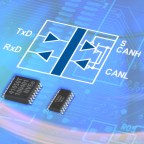NVE Introduces Low-Power Isolated CAN Transceivers EDEN PRAIRIE, Minn.—May 30, 2012—NVE Corporation today announced an expansion of the IsoLoop® IL41050 isolated Controller Area Network (CAN) transceiver family with the introduction of the lower power, ultra-rugged IL41050TA versions. The new “A” versions boast 10 percent lower quiescent and dynamic supply current than the original IL41050 versions, the IL41050T. The new IL41050TA has a maximum loop delay of 250 nanoseconds, which is sufficient for most applications. The original IL41050T has best-in-class speed with a maximum loop delay of 210 nanoseconds. The ground-breaking IL41050 family of isolated CAN transceivers was introduced in 2010. Parts are available in JEDEC-standard, RoHS-compliant, 16-pin 0.15-inch wide and 0.3-inch SOIC packages. Narrow-body versions, designated the IL41050T-3E and IL41050TA-3E, are the world’s smallest isolated CAN transceivers with minimal footprint and 1.8 millimeter clearance height. Wide-body packaged versions, designated the IL41050TE and IL41050TAE, provide a full eight millimeters creepage distance.
Advanced features allow unmatched versatility and reliable bus operation. Unpowered nodes do not disturb the bus, and a unique nonvolatile programmable power-up feature prevents unstable nodes. The devices also have a hardware-selectable silent mode that disables the transmitter. Designed for harsh CAN and DeviceNet environments, all IL41050 transceivers are rugged where it counts with a -55 to +125 degree Celsius operating range, transmit data dominant time-out, thermal shutdown protection, short-circuit protection, 2.5 kilovolt isolation, typical transient immunity of 30 kilovolts per microsecond, bus pin transient protection, and a Human Body Model electrostatic discharge (ESD) rating of four kilovolts. Unique edge-triggered inputs maximize noise immunity. The parts are UL 1577 and IEC 61010-2001 approved. Unlike optocouplers or other isolation technologies, IsoLoop isolators have indefinite life at high voltage. Bus-side dynamic supply current (dominant), is 70 milliamps maximum compared to 78 milliamps for the original version, and quiescent supply current (recessive) is 12 milliamps maximum compared to 13 milliamps for the original version. In addition to lower power consumption, the new IL41050TA has an ultra-rugged Charged Device Model (CDM) ESD rating of plus or minus 500 volts, compared to plus or minus 200 volts for the original versions. CDM specifies the most common type of electronic device ESD. The narrow-body version of the new part, the IL41050TA-3E, is in stock for immediate delivery; the wide-body version IL41050TAE will be available in August 2012. Pricing for the IL41050TA-3E and IL41050TAE is $2.33 each for 1,000 pieces. Datasheets and more information are available at www.IsoLoop.com or www.nve.com. NVE’s award-winning IL400/IL3000 line of isolated transceivers includes RS-422, RS-485, and PROFIBUS protocols; speeds up to 40 megabits per second; digital and passive input versions; and unique 0.15-inch narrow-body packages. NVE is a leader in the practical commercialization of spintronics, a nanotechnology that relies on electron spin rather than electron charge to acquire, store and transmit information. The company manufactures high-performance spintronic products including sensors and couplers that are used to acquire and transmit data. NVE has also licensed its spintronic magnetoresistive random access memory technology, commonly known as MRAM. Statements used in this announcement that relate to future plans, events, or performance are forward-looking statements that are subject to certain risks and uncertainties including, among others the risk factors listed from time to time in our filings with the SEC, including our Annual Report on Form 10-K and other reports filed with the SEC. ### |
